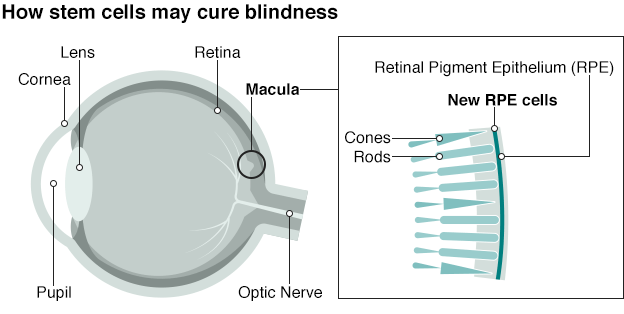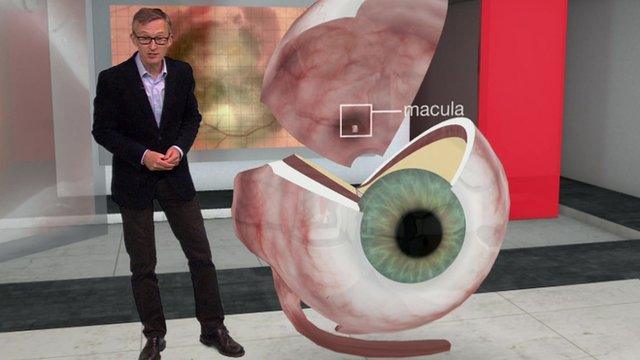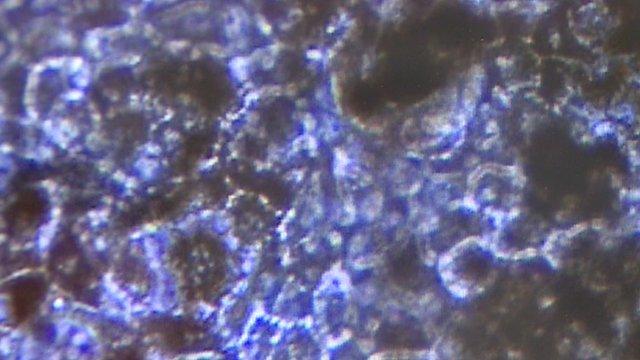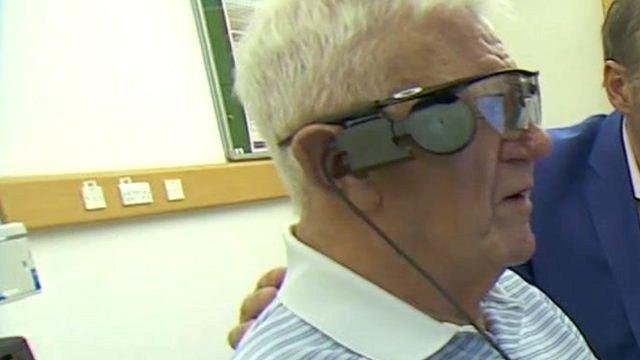Stem cell trial aims to cure blindness
- Published
- comments
What causes age-related macular degeneration?
Surgeons in London have carried out a pioneering human embryonic stem cell operation in an ongoing trial to find a cure for blindness for many patients.
The procedure was performed on a woman aged 60 at Moorfields Eye Hospital.
It involved "seeding" a tiny patch with specialised eye cells and implanting it at the back of the retina.
The London Project to Cure Blindness was established a decade ago to try to reverse vision loss in patients with age-related macular degeneration (AMD).
Ten patients with the wet form of AMD will undergo the procedure.
Ten patients will be monitored for a year to assess how successful the pioneering technique for curing blindness could be
All will have suffered a sudden loss of vision as a result of defective blood vessels in the eye.
They will be monitored for a year to check that the treatment is safe and whether their vision improves.
The woman who was the patient - and does not wish to be named - had the operation last month.

Prof Peter Coffey, of the UCL Institute of Ophthalmology, who is co-leading the London Project, said: "We won't know until at least Christmas how good her vision is and how long that may be maintained, but we can see the cells are there under the retina where they should be and they appear to be healthy."
The cells being used form the retinal pigment epithelium (RPE) - the layer of cells that nourish and support the photoreceptors in the macula - the seeing part of the eye.
In macular degeneration, the RPE cells die, and as a result the eye loses function.
Patients with AMD lose their central vision, which becomes distorted and blurred.
The cells used in the operation were originally derived from a donated early embryo - smaller than a pinhead - which has the potential to become any cell in the body.
Bryan Naylor: "It's the breakthrough we've all be waiting for"
Prof Lyndon Da Cruz of Moorfields Eye Hospital, who carried out the surgery, said: "This is truly a regenerative project. In the past it's been impossible to replace lost neural cells.
"If we can deliver the very layer of cells that is missing and give them their function back this would be of enormous benefit to people with the sight-threatening condition".
If the treatment is successful, the scientists say, it would also help patients in the early stages of dry AMD, and could potentially halt their vision loss.
AMD affects more than 600,000 people in the UK and is the leading cause of sight loss in the developed world.
It is estimated that one in every 10 people over 65 has some degree of AMD.

Loss of sight with macular degeneration
The team at Moorfields is working in partnership with the pharmaceutical company Pfizer, which is funding the trial.
It is not known how much the one-off surgical treatment might cost, although the scientists involved point out that treating and dealing with sight loss is a huge burden on the NHS.
It is not the first time that scientists have used stem cells derived from human embryos in patients with sight loss.
In 2012, patients with Stargardt's disease - which leads to progression deterioration of vision - were injected with embryonic stem cells in a safety trial carried out in the US and UK - which also involved a team at Moorfields.

AMD
Age-related macular degeneration (AMD) is a painless eye condition that causes you to lose central vision, usually in both eyes
This makes reading difficult, colours appear less vibrant and faces can be hard to recognise.
Peripheral vision remains unaffected, so while it won't cause complete blindness it is debilitating
AMD affects more than 600,000 people in the UK and is the leading cause of vision loss
It is more common with age and there are two main types - wet AMD and dry AMD
Dry AMD is the most common and least serious type and develops when cells at the back of the eye become damaged by the build-up of deposits
Wet AMD is more serious and develops when abnormal blood vessels form and damage the cells at the back of the eye
There is currently no cure for either type

Of more relevance to the current trial are the 40 AMD patients already treated at Moorfields with cells taken from their own eyes.
Prof Da Cruz said "We saw extraordinary recovery, with some people being able to read again and drive, and that recovery being sustained for years."
He explained that using the patient's own cells was complex and carried risks, which is why the London Project opted for the embryonic stem cell line, which can produce a limitless supply of specialist cells.
Prof Da Cruz said animal studies had shown that surgery to introduce the sheet of cells into the eye was feasible.
So although the team cannot say whether this trial will work, the years of planning give them confidence that this treatment has huge potential.
It is far too early to make any judgment, but if successful, it would be a stunning medical advance of huge implications.
The results from the first patient, and subsequent volunteers, will be eagerly awaited.
- Published29 September 2015

- Published29 September 2015

- Published29 September 2015

- Published21 July 2015

- Published24 January 2012
- Published22 September 2011